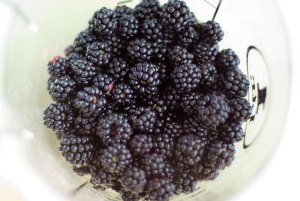
These rolls are a bit like cinnamon rolls, but filled with apricot jam and some other yummy things. My mom found this recipe in a German baking magazine ages ago and it’s a regular in our recipe repertoire since the first time we tried it out. I was still a kid and soon I started making this on my own. Mind you – yeast dough! Don’t be afraid, it’s so easy a kid can do it!
Follow me and I show you how it works.
DOUGH
1 packet or cube of yeast
125 ml / 1/2 cup milk, warmed (water also works)
500 g / 18 oz / 4 1/2 cups flour
50 g / 1/4 cup sugar
2 eggs
150 g / 1 1/2 sticks butter, room temperature, cut into cubes
1/2 teaspoon salt
FILLING
200 g / 7 oz / 2/3 cup apricot jam
100 g / 3.5 oz / 1/2 cup sugar
100 g / 3.5 oz / 1 cup chopped almonds
100 g / 3.5 oz / 3/4 cup raisins
1/2 teaspoon cinnamon
2 tablespoons rum
GLAZE
6 tablespoons powdered sugar
some drops of lemon juice

Behold!!! The mighty yeast. Alton Brown would say something like that. I say: Don’t worry, it’s just yeast. Only costs cents in the supermarket. I also always have dried yeast packages in my pantry, but I like the original stuff better. Maybe because you can feel and smell it.

Bring half a cup of milk to body temperature. I kicked out my microwave – it took too much space – so a measuring cup on the stove works great. The milk should be just as warm as your finger.
Umm, yes. The stove is dirty and has some cracks. I do not have a perfect kitchen.

Put the flour in a mixing bowl (no need to sift) and push it to the sides. Crumble in the yeast (hmm, smells good) and sprinkle in the sugar. Pour over the warm milk and let it all sit for 15 minutes.

Oh my god! It’s alive! Well, the yeast becomes active with sugar, water and warmth.
It starts eating the sugar and digesting it into carbon dioxide, which results into those teeny tiny bubbles that make the dough fluffy. And alcohol, but here are only trace amounts. Leave the dough sit for 3 days and you will taste the alcohol. It’s the same yeast the use for beer brewing.
Crack in the eggs and add the butter cubes, then start mixing on low with a dough hook.

Keep mixing on medium-low until all the butter pieces are gone and the dough is not sticking to the bowl any more. At first, things will be very sticky, so keep the machine running until you see it coming off and basically could take out the dough and have clean bowl. Rather clean bowl, the bottom will always stick a little.
Cover with a tea towel and place the bowl in a warm space for around 30 minutes, if you’re impatient. Or just leave it where it is for an hour or two. And if you really have time on your hands, put it in the fridge overnight. The slower and colder the process, the finer the taste and texture of the dough.

Key is, the dough should double in size. Sometimes it even triples in size. See the fluffy texture? Just like a pillow.

In the meantime, mix together all the ingredients for the filling. Nothing special about that.

Get the dough out of the bowl and onto your favorite rolling surface. I like my extra big silicon mat.
Press the big air bubbles out and knead it a bit. No need to get aggressive (but do, if you feel like it!), just work it through to redistribute the butter and the yeast.
That day, I decided to bake only half of it and freeze the rest. Works wonderfully. And the flatter you press the dough the faster it will freeze. And unfreeze, which can be really important…

Now, roll out the dough patiently and gently. Try to get it as thin as possible, this was about 3 mm. Just don’t go too thin or it will tear. Then trim the edges so that you will have roughly a rectangle.

Spread on the yummy apricot mixture and start rolling it up. It’s up to you if you start from the long or the short edge, depending if you like thinner or thicker rolls.

Cut this dough roll into 1 inch / 2.5 cm slices, this works best if you froze it for half an hour or use a really sharp knife. Place them in a pie pan or directly on a baking sheet. Be patient and let them sit there for another half an hour.
Depending on the time your oven needs, preheat to 200°C / 400°F.

Bake for 12-15 min, until golden brown and delicious. They’re great just like that, but even better with a glaze.

And this is really simple – just mix the powdered sugar with some drops of lemon juice until you have the consistency of honey.

Spread it on the rolls, lick your fingers and spoon clean of the glaze and then take a blissful first bite.



























